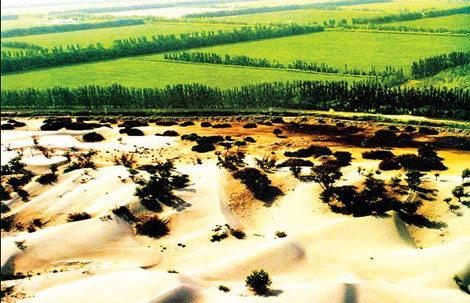Xpcc Special
50 years of modernizing agriculture
By Mao Weihua and Shao Wei (China Daily)
Updated: 2010-11-29 07:59
 |
Large Medium Small |
|
|
URUMQI - The total agricultural production of the XPCC, in 2009, was worth 43.4 billion yuan, a year-on-year increase of 7 percent.
The added value output amounted to 20.5 billion yuan, an increase of 7 percent.
Per capita net income of farmers and herdsmen of the XPCC reached 7,668 yuan, a 13.3-percent increase, year-on-year.
By the end of 2009, the XPCC had 1.04 million hectares of arable land, 30,000 hectares of forested area, and 2.4 million hectares of pastures.
It also had 125 reservoirs and 10.75 billion cubic meters of surface water. The underground water was figured at 1.63 billion cu m.
By the end of 2009, the XPCC had 412,800 people working in agriculture, forestry, animal husbandry, the food and beverage sector, and fisheries, or a decrease of two percent from 2008.
In 2007, the State Council asked the XPCC to set up a water-saving irrigation base, agricultural mechanization base, and a modern agriculture base as national models.
So, the XPCC established goals for these promotion and demonstration areas. It plans to change from an economy dominated by agriculture to one dominated by industry by the end of 12th Five-Year Plan period (2011-2015).
By that time, the income from livestock, gardening, vegetable and fruit industries will account for 50 percent of the total value of agricultural production.
The processing rate of agricultural products will increase to 60 percent from the current 20 percent.
Cotton output is expected to top 1 million tons at the end of 2015 and to account for one-sixth of China's total cotton output.
The grain production capacity is expected to reach more than 3.5 million tons.
The XPCC's contribution to modern agricultural science and technology is expected to reach 70 percent to the modernizing agriculture, ranking at the top in the nation.
Farm mechanization will have reached 92 percent of the XPCC's farmland by the end of 2015.
Per capita net income of farmers and herdsmen is expected to reach 10,000 yuan in 2015, an average increase of nearly 10 percent from 2010 to 2015.
The XPCC has tried to modernize its agriculture, and its water-saving methods are a good example of its work.
Growing rice on dry land is not easy, especially with drip irrigation system, but the XPCC's Xinjiang Tianye Group has performed miracles in this, with a bumper harvest this month.
The company has a park with 27 hectares of dry ground for a rice paddy, crisscrossed with pipes that irrigate the crops automatically.
"Average rice output per hectare is 11,085 kg, while the amount of water for irrigation is 60 percent less than in traditional rice growing," said Guo Qingren, the Tianye Group's chairman.
This environmental theme park is the epitome of efficient irrigation technology. Previously, it was used just for cotton, but is now being used for other crops grown by the XPCC, such as corn and red jujubes.
Development path
The XPCC, which founded in 1954, had 175 farms in 14 divisions and a population of 2.57 million living and working in the land area administrated by the organization, at the end of 2009.
The majority of its farms are located on the edge of deserts or border areas where water is in scarce supply, so it has been determined to popularize a more efficient use of irrigation in its reclamation farms, since 1980s.
